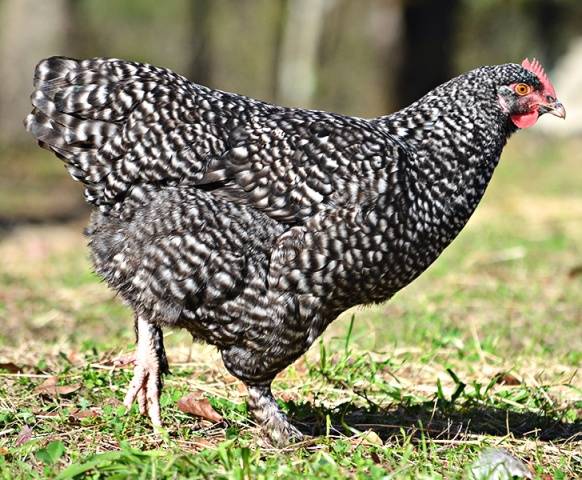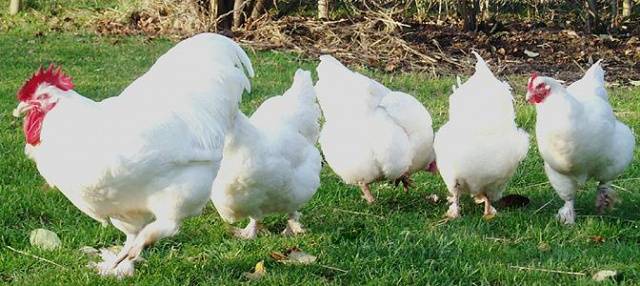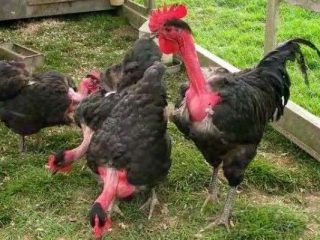Content
The Mechelen breed of chickens, which according to English-language sources is on the verge of extinction, dates back to the 19th century. Chickens were bred in the Mechelen region in the Antwerp province. The breed got its name from the place where it was bred. The second part of the breed's name indicates the most common plumage color. Most of these chickens are cuckoo colored. The Mechelen cuckoo originated from crossing local Belgian chickens with oriental fighting breeds. Along with Jersey Giants This is the largest variety of chicken of all available breeds.
The Mechelen cuckoo breed of chickens came to Russia even before the revolution. At that time, among aristocrats and persons aspiring to the highest circles of society? French was in vogue. The Mechelen region is called "Malines" in French, and chickens at that time were called Coucou de Malines. Later this name was naturally shortened to "Malin". Yes, it still remains that way. Interest in these birds in Russia is being revived again, and in Russian-language sources you can more often find advice on how to breed not the Mechelen cuckoo, but the Malinov.
Description
Mechelen cuckoo chickens belong to the meat production category. The weight of an adult rooster is 5 kg. Adult laying hens are not much inferior to males: 4-4.5 kg.It will be difficult for a simple fan to determine from the photo and description whether he bought a purebred Mechelen cuckoo chicken, since at the beginning of the 20th century a second version of this breed appeared.
The original raspberry has a single leaf comb. But at the beginning of the 20th century, due to the demand of the German army for the largest possible chickens, the Malin was crossed with another Belgian breed of fighting origin - the Bruges Wechter. This is the oldest fighting breed in Belgium, the roosters of which exceed the Mechelen cuckoos in weight. Brugge Wächter gave the heavier version of Malinov's original triple pod-like comb. Today there are only a small number of such birds and the main one is the leaf-shaped crest. But Malin with a triple comb is not a crossbred.
The photo shows a rare version of Raspberry with a pod-like ridge.
The description of the Mechelen Cuckoo chicken breed indicates that even today breeders are working to increase the productivity of birds. Goal: 4 kg of live weight in 10 weeks, subject to growing technology. In this way, Mechelen cuckoo chickens are similar to broiler crosses, but are superior to broilers in other qualities:
- absence of lethal hereditary problems:
- the ability to reproduce “in oneself”;
- no problems with bone growth;
- not susceptible to heart attacks;
- good featherability;
- cost-effectiveness in feed.
The Malins' development does not go beyond their physical capabilities.
This quality can be attributed to the disadvantages of the breed, since to breed chickens of this breed you will have to purchase an incubator.
Standard
The description of the Mechelen cuckoo chickens clearly indicates the meat direction of the productivity of these chickens. These are powerful, stocky birds with strong legs. Due to their large body mass, birds are very clumsy and incapable of flight.
The head is medium in size with a small, usually leaf-shaped crest. The number of teeth on the comb varies from 4 to 6. The eyes are orange-red. Earrings and earlobes are bright red, oblong, medium in size. The face is red. The beak is short. The beak color is light, maybe white.
The neck is relatively long and powerful. Placed vertically. The mane of roosters is poorly developed. The body is located horizontally relative to the earth's surface. The back is very wide and straight. The tail braids of roosters are poorly developed. In general, the tails of Mechelen cuckoos are not distinguished by their splendor. The top line of representatives of the breed resembles the letter U. In roosters, due to the vertical position of the tail, the “letter” is more pronounced. The tail of laying hens is set more horizontally.
Although the shoulder girdle of chickens is very powerful, the wings themselves are small. This feature deprives chickens of the ability to fly. The wings are tightly pressed to the body, almost hidden under the feathers covering the lower back.
The chest is wide, full, with well-developed muscles. The abdomen is well developed and full. When viewed from the side, the bird's body resembles a regular ball. If you mentally remove the tail and neck.
The legs are strong, with thick metatarsal bones. The thighs and legs are well muscled. The color of the metatarsals is most often white-pink; in black birds the metatarsals may be dark gray.
In the photo of the legs of the Mechelen cuckoo chicken breed, you can clearly see where exactly the feathers on the metatarsals should grow.
The plumage of chickens is thick and dense. The most common color in the breed is variegated, which in the West is divided into two types. They differ in the thickness and number of alternating black and white stripes on the flight feathers.
In total, 8 color variants are recognized in Belgium, and 9 in Germany. Descriptions and photos of some colors of the Mechelen cuckoo chicken breed are almost impossible to find. In Russia there are two varieties of pieds: cuckoo and hawk. And white, considered very rare.
By European standards, white color is the second most common color. The photo of black Raspberry is already exclusive.
Lavender color is a weakened version of black.
Photos of the Colombian and silver Malinov are completely missing. And the golden one is shown only in the picture.
Birds have an easy-going, calm disposition. It is difficult for them to start fights with such a large body weight.
Vices
Even taking into account the fact that the breed is rare and the Malin population in Russia is very small, a bird with the following characteristics cannot be left for the tribe:
- underdeveloped pectoral muscles;
- white lobes;
- narrow back;
- triangular body shape;
Among the defects, too light a color is often cited, but this can only be attributed to a variegated color, since lavender or Colombian are light in themselves.
Productivity
Malins have a fairly high egg production rate for a meat breed of chicken. They are late ripening and begin to lay eggs at 6.5 months. If feeding is not of sufficient quality, development is delayed and the period of egg production begins at 8 months. The Mechelen cuckoo lays 140-160 eggs per year.The weight of one egg is 60-65 g. The color of the egg shell of the Mechelen cuckoo chicken breed is pale pink. The photo shows the difference between the Raspberry egg and the eggs of other chicken breeds.
Reviews about the meat of the Mechelen cuckoo chicken breed are only positive, as well as about the weight gain of chickens. The meat is very tender, with a fine structure.
Roosters quickly gain weight and at four months a gutted carcass without neck and paws weighs 2.2 kg. Accordingly, the live weight of a four-month-old cockerel exceeds 3 kg. According to Malin's owners, a 9-month-old rooster can even exceed 6 kg. But these are those selected for fattening, not for breeding.
The photo shows the legs of a 2-month-old chicken. The whole chicken didn't fit into the frame.
Chickens
Nowadays the problem of buying Mechelen cuckoo eggs is not as acute as it was several years ago. It has become possible to buy them in Russia, where the variegated variety is mainly bred. Because that's how it was once delivered. Even yellow chickens often develop gray feathers. But the standard motley color is more convenient for breeding, since these chickens are autosex. The description and photo of the chickens of the Mechelen breed of chickens allows one to clearly distinguish between one-day-old chicks, cockerels and hens: the hens have a pure black back, and the cockerels have a blurred light spot on the back.
In this photo there are only two chickens in the upper right corner of the container.
Considering that laying hens have no desire to tinker with chickens, it is better to take Malinov with eggs. Although, it may turn out like in the photo above: out of 12 chickens, 10 cockerels. Western breeders would only be happy and sell the extra males for meat. In Russia, this is more difficult until the chicken population reaches a decent size.
It is better to take the first eggs for incubation from birds that fall into the standard, but do not differ in gigantic size. According to reviews, the larger the Mechelen cuckoo, the fewer eggs it lays. The fertilization rate of Malin eggs is very high, up to 98%. But this is provided that the rooster in the breeding flock is not very large. If the rooster is too large, the fertility of eggs is reduced by 40%.
The hatchability of chickens in the incubator reaches 90%, and the survival rate is 95%. Chickens require high-quality feed and coarse shavings or straw. Due to slow fledging, elevated temperatures in the brooder must be maintained until the chicks reach 3 months of age.
Content
English-language sources indicate that raspberries can even live in cages, but the best results will be obtained if the birds have a large range. Another problem with cage keeping and a cramped chicken coop is that the Mechelen cuckoo’s metatarsals are heavily feathered. The video shows that the feathers are long and touch the ground.
Keeping it on a dirty floor will cause droppings to stick to your feathers and fingers. Such lumps become very hard and the chicken cannot remove them on its own. If you miss the moment and the lump of droppings remains on the paw for a long time, it can lead to tissue necrosis.
The perches for these birds are kept low, but it must be remembered that their advertised inability to fly is conditional. The fence for these chickens should be more than a meter high.
Reviews
Conclusion
Neither the photo, nor the description, nor the reviews convey the greatness of the Mechelen cuckoo chickens, which majestically walk around the yard. The birds are really not inferior in size to other large meat breeds of chickens. Their tender, tasty meat attracts Russian poultry farmers, who raise this Belgian chicken in their backyards. It may well happen that soon in Russia the Coucu de Malin will again become not a rare, but a common breed of meat chicken.
























